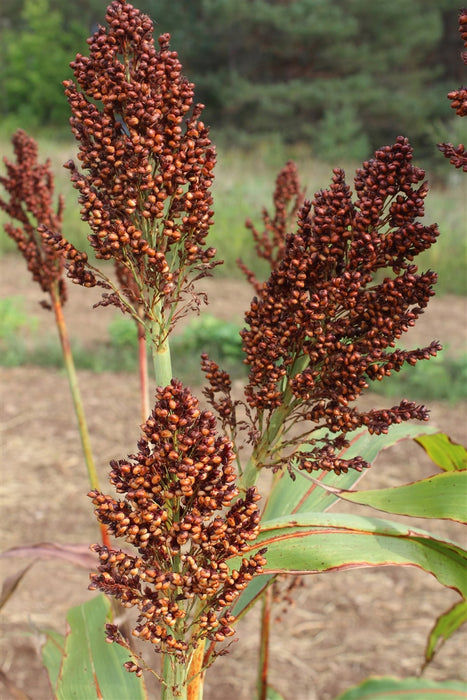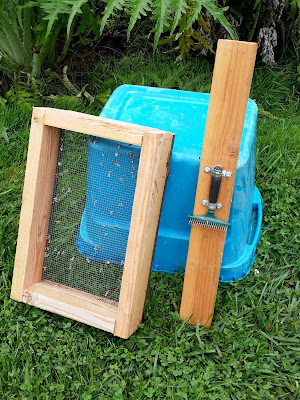Small-Scale Grain Production and Processing
For the past few years, the Sharing Gardens have been growing sorghum, amaranth and corn to process and use in baking, and breakfast cereals. This post is specifically about growing, processing and storing sorghum on a small-scale. (Image left: Kassaby sorghum ripening.) To read about growing blue corn, and for other relevant LINKS, see below. |
| Rook and Chris harvesting Ba Ye Ki sorghum. |
 |
| Though sorghum has no gluten, when mixed with wheat flour, it still makes wonderful baked goods. Here it is with a Whole Grain No-knead Bread recipe we've made. |
Growing conditions needed: Sorghum grows to various heights (up to 12 feet!). The plant, in early stages, looks very similar to corn. We have experimented with two varieties, Ba Ye Ki and Kassaby. (Ba Ye Qi Grain Sorghum, Ba Yi Qi Grain Sorghum (Milo) and Kassaby Sorghum - description). Ba Ye Ki is a very short-season grain so we're almost guaranteed a ripe harvest but it is also much less sweet than Kassaby - whose canes have been compared in flavor to sugar cane. Ba Ye Ki is shorter in height (6'-7') vs. Kassaby which can grow to 12'. Because of Kassaby's greater height and its higher sugar content, it also requires a longer growing season. Both can grow in moderately rich soil but do require regular, moderate irrigation to really thrive (though I'm sure that people who have experience at dry-land farming could achieve success with less, or no watering, we have not developed that capacity on our farm).
 | |
| Ba Ye Ki sorghum: a shorter crop (5'-7') and shorter season grain. Not as sweet... (pic credit: https://annapolisseeds.com/products/ba-ye-qi-sorghum) |
 |
| ...as Kassaby sorghum: taller (9'-12'), longer season, sweeter. Stalks can be pressed for syrup (though we've never tried it). (Image credit: https://store.experimentalfarmnetwork.org/products/kassaby-sorghum) |
Trellising: We have grown both varieties with, and without trellising. Kassaby - the taller variety has a sturdier stalk and seems to do fine without trellising. Ba Ye Ki, which produces grain faster, puts less energy into stalk formation and, in our experience, is prone to lodging. This can be mitigated somewhat by growing it in multiple rows or blocks of grain, with approximately 6" between plants in all directions. The plants will tend to hold each other up.
 |
| Another trellising idea is to plant your grains inside a wire cage (6" between each plant, in each direction). The cage will keep them from lodging. This works for fava beans too! |
Sorghum is largely self-pollinated (each plant can pollinate itself) but plants can also cross-pollinate through wind or insects transferring pollen between plants. Growing multiple plants in rows or blocks will aid in cross-pollination. Also, when laying out your garden plan, keep in mind the height of the variety you are growing so they don't block smaller plants of sunlight and water as they grow in height. (Though you can use their height to your advantage if you want to grow a shade-loving crop like lettuce, on the north or east side, to protect it from the most intense afternoon sun.)
The down-side to the scatter method is that some varieties need a long season to ripen (Kassaby variety needs 110 days, minimum) so, if you're having a cool, wet spring and can't direct sow till late in the spring, you may wish to germinate the seeds in small pots in a greenhouse or grow-tunnel and transplant them once the ground warms up/drys out. We use jumbo six-packs, or the shallow, plastic containers that our favorite tofu comes in (with holes drilled in the bottom for drainage). To germinate in pots: we fill the pots with soil, water them and then make a small indentation with our thumb so the seeds will settle in these depressions (six per tofu pack). We then place 2-3 seeds in each cell to maximize germination. Once the seedlings are about 3" high, we thin them to one per cell.
If you try to grow them in a clusters of 2-3 plants, none of them will mature well as they compete for nutrients, water and sunlight. We have had success at teasing the individual sprouts apart at this stage and replanting them in their own cells. It just depends on if your supply of seed is limited so you need to make every seedling count and how much time you have to do this.
When to harvest: It's important to let your sorghum ripen as much as possible before harvesting. The seeds will be sweeter, and easier to thresh (remove) from the plant, the riper they are. On the other hand, autumn rains, if they aren't followed by strong sunny periods can lead to mold forming in the seed-heads. We start checking our crops for ripeness in mid-September. The Ba Ye Ki will darken to a strong russet/red. The Kassaby will become notably whiter as it ripens.
We usually harvest the seed-heads over a span of several weeks. We use pruners to cut off ripe seed-heads with 8-10 inches of stalk still attached. This helps in the drying out process; the stalks draw moisture from the seed-heads as they dry. Having the long stalk also gives you something to hold onto for the threshing phase.
 |
| Kassaby, long-season sorghum (tall and sweet) while it's still ripening. Kernels become a pearly white when they are ripe. |
If we're having mostly sunny days with only moderate humidity, we lay the seed-heads on cardboard trays in our greenhouse to dry. If skies are overcast and the humidity is high, we put them in cardboard trays or baskets and bring them in the house. We heat our house with wood and have shelves all around the upper walls of our living room where our wood stove is, for the purpose of drying foods in the fall. Many fall mornings we'll start a small fire in the wood stove just to dry the air in our house and bring the temperature up slightly. Even if we have to open the windows later in the day (because outside temps have climbed) it's worth the few sticks of firewood to keep the drying process progressing.
Threshing the sorghum: We've tried several methods over the years to remove the grain from the stalks but this year Chris came up with our best method yet! He attached a metal pet-grooming-brush/comb to a 2' x 4' board (see pic). This is placed in a deep plastic tote to catch the seed as it falls. The seed-head is combed through the tines of the comb which causes the seeds to release and fall into the tote below.
 |
| This year, Chris built two new tools for processing the sorghum. Sifter, on the left, and a pet-comb attached to a 2'x4', for teasing the grain off of the stalk (right). |
 |
| Close-up of the tool we use to thresh the grain from the stalk. It's a pet-comb we found at a 2nd-hand store, bolted to a 2'x4' board. |
 |
| Close-up of pulling the grain-heads across the comb. This is why we always cut the grain-heads leaving several inches of stalk for use as a handle. |
Winnowing: There will still be some fiber that makes it through the screen so, on a day with a mildly steady wind (or standing in front of a box-fan) pour the grain back and forth from one container to an other. You will have to experiment to find the right height from which to drop the grain and, if using a fan, how far from the front of the fan to pour the grain. It's helpful if your containers are lightweight (so it's easy to pour them when full of grain) and with a wide surface area so that, as the grain falls straight down, it's not bouncing off the rim of the receiving container. The grain will fall straight into the container below and the chaff will be blown away by the wind.
 |
| Here's a top view of sorghum heads drying in a basket. |
 |
| Chris hooked up our Diamant grain mill to an electric motor so we're able to efficiently grind enough grain for our own use as well as to share with our volunteers. |
 |
| Course ground sorghum for use in hot cereal. |
Here is the post we wrote about growing and processing your own blue corn for drying and grinding. These methods also work for growing/processing Golden Bantam and other varieties of corn. Grow Your Own 'Blue Corn'
And here's a recipe we've developed to make a Crumb-Free, Whole-Grain Cornbread (just substitute sorghum flour in a 1:1 ratio with the corn flour in the recipe).












































